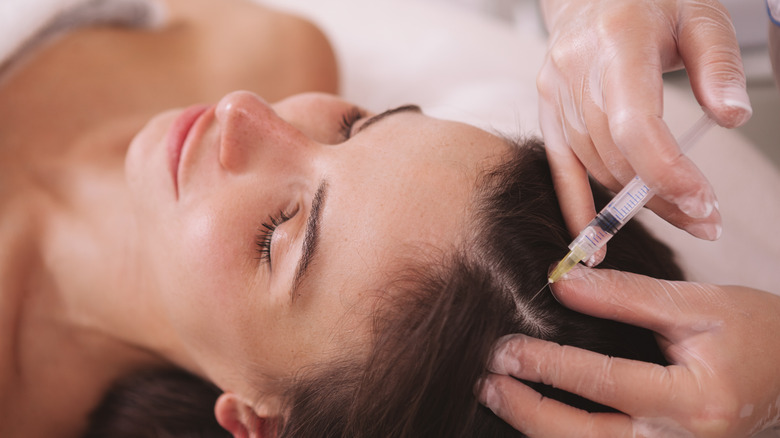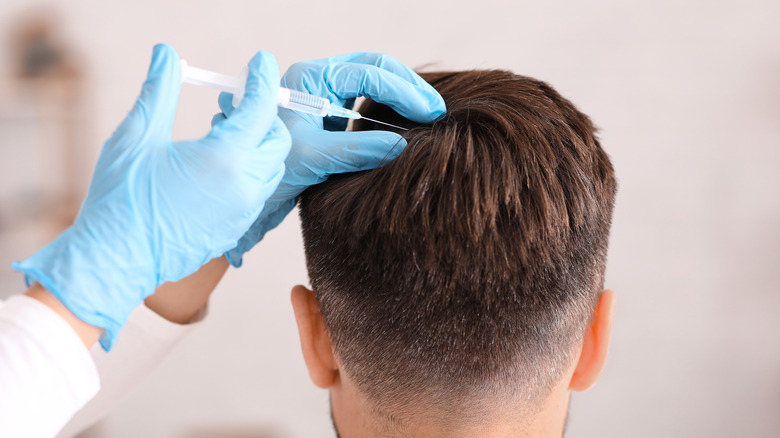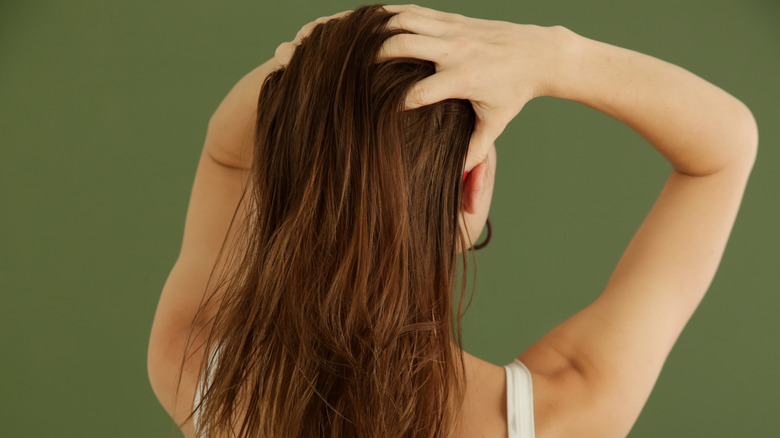People Are Getting PRF Injections In Their Scalp For Hair Regrowth, But Does It Work?
Because it's a condition that affects millions of people in the U.S., hair loss solutions are commonly spread around on the internet. The hashtag on TikTok has over 5.7 billion views and counting, with countless videos discussing struggles with hair loss and the remedies used to grow hair stronger and longer.
Whether the problem is daily hair loss or normal shedding, the desire for hair loss antidotes will be strong. From weekly scalp massages with rosemary oil to at-home microneedling, it isn't uncommon to witness growth for minor bald patches or a bit of thinning on the hairline.
However, essential oils aren't always going to cut it, and neither is scalp stimulation. For people whose hair loss is starting to progress past the point of home remedies, they may want to consider going to a professional for their hair loss. If you notice that you're starting to lose more hair than normal and don't want to leave the health of your hair in your own hands, consider getting PRF injections.
What are PRF injections?
Platelet-rich fibrin (PRF) injections are made with a combination of your own blood and fibrin – a protein that stimulates stem cells and heals wounds. Derived from platelet-rich plasma, the treatment uses less blood than its originator and is 100% natural. When you go in for a PRF injection, an anesthetic cream will be applied to the scalp and the dermatologist will draw blood and put it into a machine called a centrifuge that separates the items in a sample.
Once the PRF is separated from your blood, it will be injected into your scalp in the area that you're experiencing hair loss. PRF has proven to be a safe procedure, with 80% of participants experiencing successful injections. It's done in a series of four treatments with a maintenance treatment done every six to 12 months after the first four initial treatments are completed.
Outside of experiencing hair loss, the main requirement for receiving PRF injections is to have healthy, functioning white blood cells and platelets. The best candidates for these injections are in the earlier stages of hair loss, or androgenic and traction alopecia, when the hair follicles still have a chance at growing hair. As for side effects, redness, swelling, slight pain, and itching are quite common days after the injections. Although it's based on location, you can expect to spend anywhere between $1,500 to $5,000 for the treatment.
Other effective treatments for hair loss
The price of PRF injections is a bit steep and if you can't afford them, there are other options. A common hair loss treatment, Minoxidil is both an oral and topical treatment for hair loss. The topical form of it comes in both a solution and foam that can be recommended to you by a dermatologist. The dosage will be based on the condition of your hair loss. For a lower dosage of the treatment, the oral version improves the volume and thickness of the hair.
If you have alopecia areata, a condition in which your body attacks its own hair follicles and creates bald patches, corticosteroid injections may be more suitable for you. With treatments every four to six weeks, steroid injections stop the immune system from attacking the hair follicles.
However, it can come with a host of side effects, such as acne, hyperpigmentation, or skin thinning at the injection site. Although the amount needed for a hair loss injection is small, there's still a slight risk of the corticosteroids being absorbed by other parts of the body, which can result in temporary problems with your immune system or a change in your menstrual cycle. Speak with your dermatologist before trying any treatments for hair loss.


